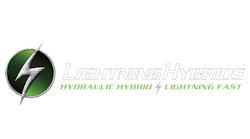Testing Shows Lightning Hybrids Provides Emissions Reductions
Independent tests on Lightning Hybrids’ hydraulic hybrid system for medium- and heavy-duty trucks and buses show that the technology consistently and significantly reduced harmful vehicle emissions, regardless of OEM platform.
The tests compared GM gasoline and diesel powered chassis with and without the Lightning Hybrids system activated. The same gasoline engine is used for some Freightliner Custom Chassis applications. Testing was done on both the Orange County Bus drive cycle and on the Braunschweig City drive cycle. (Read the White Paper here.) Results showed:
- The gasoline engine’s NOX output was 0.15 grams per mile on the OC Bus drive cycle, with the Lightning Hybrids system installed. This can be compared with the NOX output of a GM diesel engine on the same platform and drive cycle but without the Lightning Hybrids system, which emitted 4.23 grams per mile – making the hybridized gasoline vehicle an astounding 28 times less polluting than the equivalent conventional diesel vehicle.
- The NOX output for the same gasoline engine without the Lightning Hybrids system was 0.31 grams per mile – twice as polluting as the same vehicle with the hydraulic hybrid system installed.
- The LH-equipped vehicle saw 18 percent decreases in CO2 emissions versus the same baseline vehicle on both drive cycles.
Lightning Hybrids met or exceeded all California Air Resources Board (CARB) Heavy-Duty hybrid emissions certification standards using published HD HEV Certification Test Procedures.
“As the first hybrid technology developer to focus primarily on emissions reductions for medium and heavy-duty vehicles, these results – immediate, material, and consistent emissions reductions – come as no surprise to us,” said Tim Reeser, President and Co-Founder, Lightning Hybrids. “Regardless of platform, engine or fuel types tested, the results tell the same story – that Lightning Hybrids’ system is the right technology for fleets to deploy to make a significant impact on their emissions reductions commitments.”
Beyond the emissions benefits, customers can expect up to 35 percent improvement in fuel economy with the Lightning Hybrids system, which uses hydraulic pumps and a lightweight accumulator system that stores braking energy and transfers it back to the wheels during acceleration. The technology also provides longer brake life, enhanced low-end torque and lower maintenance and operational costs. Earlier this year, the company received a full U.S. utility patent for the fourth generation of its parallel hybrid system, which operates without the use of batteries.
“This system is the only emissions reduction solution available for new and retrofit platforms that will pay for itself through fuel savings within half the life of the vehicle – making it a must-have for fleet owners,” continued Reeser.
Brian Johnston, lead engineer for the emissions testing program at Lightning Hybrids stated: “Not every hybrid technology is capable of these levels of emissions savings, especially in the delivery and transit bus vocational cycles. Our hydraulic hybrids provide intense torque (up to 850 ft-lb) acceleration when emissions are at a peak. This allows us to achieve higher reductions in criteria pollutants than battery or ultra-capacitor based hybrid designs.”
Using its chassis dynamometer and certified equipment, SGS Environmental Testing Corporation ran identical agency-recognized tests with and without the Lightning Hybrids system installed. The company’s Colorado-based facility is used by major vehicle manufacturers to validate drive cycles and for high altitude testing.



